Jul 18 2016
A team of researchers from Osaka, Yamaguchi, and Kumamoto Universities in Japan have invented a method to drastically alter the fluorescence and color of a specific compound using hydrogen (H2) and oxygen (O2) gases. The entire reversible reaction is environmentally friendly as it develops only water as a byproduct.
 An efficient chemical synthesis method for picene-13, 14-dione. CREDIT: Dr. Hayato Ishikawa
An efficient chemical synthesis method for picene-13, 14-dione. CREDIT: Dr. Hayato Ishikawa
The new method uses energy obtained from the gases instead of using photo or electrical energy. This is expected to become popular in the future to switch the fluorescence and color properties. This method is capable of being used as a detection sensor for oxygen and hydrogen gases, and it can also be used for property controls of organic semiconductors and organic light emitting diodes (OLEDs).
Polyaromatic compounds (PACs) are extensively used in organic solar-cell devices, organic EL devices, semiconductor materials, and fluorescent materials. The Kumamoto University research used energy obtained from gases to activate a molecular switch in a PAC. The research focused on O2 as an oxidant and H2 as a reductant.
We tried to determine the most attractive compounds that could freely and dramatically change the optical properties of the PAC with a redox reaction. Specifically, we introduced an orthoquinone moiety to the PAC that possessed the most ideal switching properties under a redox reaction with hydrogen and oxygen gases.
Hayato Ishikawa, Associate Professor, Kumamoto University
The researchers identified the candidates with superior switching properties by screening orthoquinone comprising aromatic compounds in a computational work. The molecules considered to be the best displayed clear switching between a colored and colorless state, and between fluorescence emission and quenching.
Picene-13, 14-dione was voted to be the most ideal candidate from the computational analysis. An original protocol was then created by the team in order to synthesize the compound from petroleum raw materials that are commercially available. The vital steps for the synthesis include the ring construction reaction by an organocatalyst and the transition metal-catalyzed coupling reaction. This synthetic technique can also be used for synthesizing several other similar derivatives or compounds.
The researchers introduced a palladium nanoparticle catalyst to the synthesized picene-13, 14-dione, and this was followed by bubbling the H2 gas into the solution. Based on the predictions of the computational study, the researchers observed a remarkable change in the fluorescence and color of the solution. The solution’s color and fluorescence changed from yellow to colorless, and from non-fluorescent to blue fluorescent respectively. The succeeding reverse oxidation progressed in a smooth manner during the exchange of H2 gas for O2 gas, and the solution then returned to its original state.
When we performed a detailed analysis, it was revealed that the resultant changes in color and fluorescence were caused by two different molecular states. The prediction of these states, and our ideas about this phenomenon, were strongly supported by both the computational analysis and the experimental results. This molecular switching technology of an aromatic compound using an orthoquinone moiety is a new insight that appears to have been reported first by our research team.
Hayato Ishikawa, Associate Professor, Kumamoto University
One significant benefit of using this new method is that it is environmentally friendly as water is the byproduct of the reaction. Not much of damage was experienced by the synthetic PACs after every single reaction, highlighting the fact that molecular switch comprises outstanding reusability.
We have considered a wide range of future applications for this molecular technique. For example, we can put this molecular sheet into a package of food filled with an inert gas to check whether oxygen, which promotes the spoilage of food, has entered the package. All that would be required is a simple check under a UV light; the package wouldn't even have to be opened. Organic semiconductors and OLEDs could also benefit from the ability to control optical properties using energy from gases. For example, organic semiconductors could be made to change their electrical properties, and OLEDs could show on/off switching characteristics by using the energy from gas that is supplied to it. The applications for this technology are numerous.
Masaki Matsuda, Associate Professor, Kumamoto University
The online edition of Angewandte Chemie International Edition features the findings of this study in its May 4th, 2016 issue.